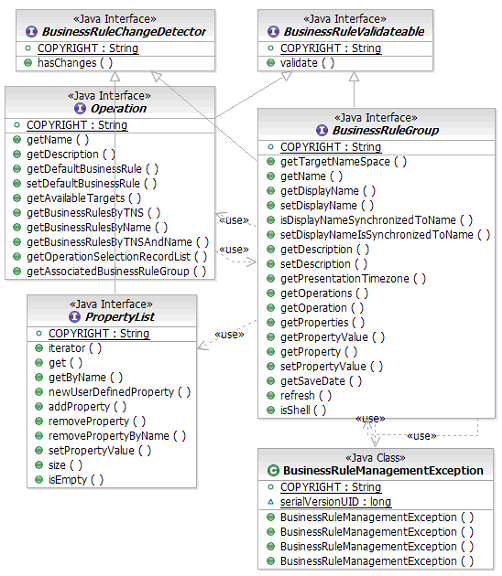IBM BPM, V8.0.1, All platforms > Programming IBM BPM > Business rule management programming > Programming model
Business Rule Group
The BusinessRuleGroup class represents the business rule group component. The BusinessRuleGroup class can be considered the root object which contains rule sets and decision tables.
Rule sets and decision tables can only be reached through the business rule group that they are associated with. Methods are provided on the class to retrieve information about the business rule group and to reach the rule sets and decision tables. Through the methods the following information can be retrieved:
- Target name space
- Name of business rule group
- Display name
- Name/Display name synchronization
- Description
- Presentation time zone which indicates whether dates should be displayed in UTC format or local to the system
- Operations defined in the interface associated with the business rule group
- Custom properties defined on the business rule group
The different rule sets and decision tables associated with the business rule group can be reached through the business rule group's operation.
There are also methods that allow for information to be updated on the business rule group. Through the methods, the following information can be updated:
- Description
- Display name
- Name/Display name synchronization
- Custom properties defined on the business rule group
The Display name for the business rule group can be set explicitly or it can be set to the value of the Name using the setDisplayNameIsSynchronizedToName method.
Other values cannot be modified as these are part of the business rule group component definition and changes to these values would require a redeploy as well as reinstallation.
The business rule group class also provides a refresh method. This method will make a call to the persistent storage or repository where the business rules are stored and return the business rule group and all of the associated rule sets and decision tables with the persisted information. The returned business rule group is the latest copy and the previous object is obsolete.
The isShell method can be used to tell if a business rule group instance is of a version that is not supported by the current runtime.
For example, if a web client was created with the current business rule management classes, and in the future new capabilities are added to the business rule group that are not supported by the classes, a shell business rule group will be created when the business rule group is retrieved. This allows the web client to continue to work with business rules that are supported and still retrieve business rule groups with limited attributes and capabilities. When isShell is true, only the methods getName, getTargetNameSpace, getProperties, getPropertyValue, and getProperty will return values. All other methods will result in an UnsupportedOperationException. Besides using the isShell method, the type of the BusinessRuleGroup can also be checked if it is an instance of BusinessRuleGroupShell in order to determine if it is of a supported version.
Figure 1. Class diagram of BusinessRuleGroup and related classes
